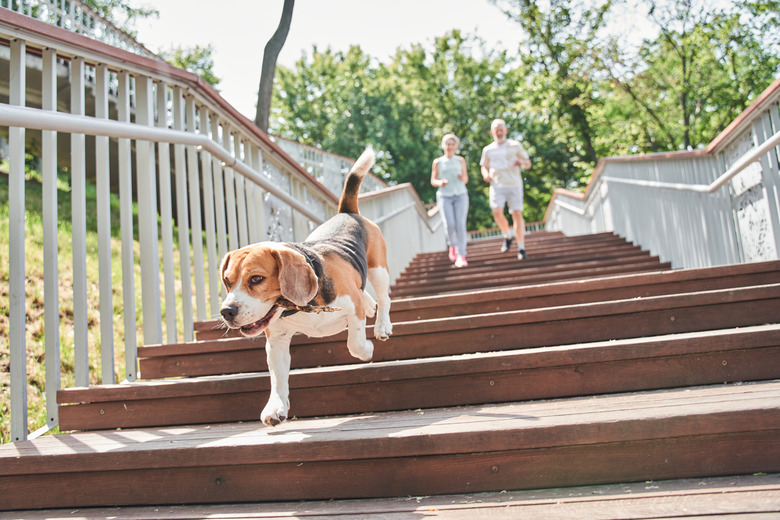An Easy Way To Prevent Dogs From Going Upstairs
It might be that your dog is getting older and has a hard time climbing down the stairs once he gets to the top, or perhaps you want to keep your heavy shedder's hair out of the bedroom areas. No matter what your reasons, simple solutions, like a pet gate for stairs combined with positive reinforcement training, can keep your pup on the ground level.
Your safety is most important
Your safety is most important
It's not unusual for dogs to enjoy curling up for a nap or having a relaxing chew session with a toy on a carpeted stair step. This can create a hazard if your dog suddenly tries to scoot out of the way or leaves her chew toy behind.
When blocking stairs from a dog, keep in mind that human safety is most important. Solutions such as laying tinfoil, sticky-side-up shelf liner or pointy-side-up carpet runners on the bottom four to five steps can create tripping hazards for humans trying to navigate the stairway.
Large dogs can sometimes jump over such blockades, risking injury from an unnatural landing on the slanted footing, not to mention the hassle of trying to detach shelf paper from your dog's coat. A pet gate for stairs can offer an easy solution provided that you can walk through the barrier without creating a further hazard to yourself or your dog. Pet gates for stairs come in a wide range of styles and colors. Be sure to consider more than just the price tag when picking out your barrier.
Choosing a pet gate for stairs
Choosing a pet gate for stairs
If you've trained your dog to respect a baby gate to keep her out of certain rooms, a free-standing pet gate might be all you need. A trifold gate is easy to stand up at the bottom of the stairway and presents a visual barrier to remind your pet that going up the stairs is off limits. Dogs might be able to hop over or push down the barrier if they don't respect the boundary, however.
A retractable mesh gate can provide an easy way to present a visual boundary to your dog to limit her access to the upstairs. Mesh fabric allows your dog to see you as you talk to her from the other side of the barrier but is small enough that she won't get her nose stuck in it. Look for a retractable gate that's certified for safe use at the top and bottom of the stairs and that has claw-resistant mesh for durability. Washable fabric can help you keep it looking fresh.
Metal walk-through gates that attach to the wall at the base of your stairwell are the most secure way for you to prevent your dog from climbing the stairs. Look for products with a metal mesh screen to prevent worries of noses, legs, or nails getting caught in the fencing. Some gates will close shut when opened partway but stay open when pushed wide to allow you to pass through with your hands full and can withstand up to 200 pounds of pouncing pressure.
Reinforce with training
Reinforce with training
A gate can provide a physical barrier, but positive reinforcement training will help your pet accept the change. Set up your dog's world so that there is no need to go upstairs. Provide food, water, treats, and a cozy, soft bed downstairs. Spend time with your dog cuddling in the living room while you watch TV. Make downstairs the happiest place in your dog's life, where he gets to spend time with you, fill his belly, and take a snuggly nap, and you'll find that he'll respect the boundaries you set.

